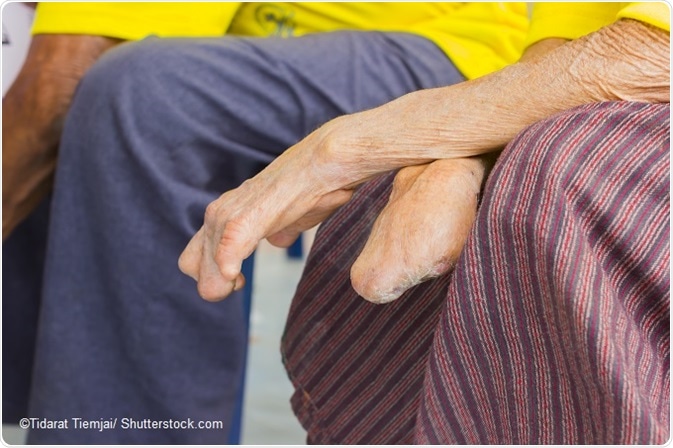The World Health Organisation (WHO) estimates show that a billion people in 149 countries suffer from one or more neglected tropical diseases. These include dengue, trachoma, filariasis and leishmaniasis, and are caused by viruses, bacteria, parasites or helminthes.

Image of patient suffering from leprosy.
These are called neglected because they do not receive much attention. They occur most often in developing countries of the world which suffer from poor sanitation, lack of potable water and deficient health care access. The importance of these diseases is both medical and socio-economic.
They cause chronic ill-health, slow development, inability to work and disfigurement. This may range from the elephantine leg of filariasis to the facial lesions of leishmaniasis. These in turn reduce the patient’s ability to earn a steady income, intensify ostracism and further poverty.
There are 17 NTDs at present, including:
- Leprosy or Hansen’s disease – a bacterial disease, contagious after prolonged contact, which develops very slowly, affecting the nerves to cause loss of sensation and motor deficit, repeated injuries and loss of tissue, leading to characteristic deformities.
- Trachoma – a leading cause of preventable blindness, it is caused by chlamydial eye infection, which is transmitted by direct contact with the infected discharge, the patient’s nasal secretions, or contact with surfaces contaminated with the discharge.
- Buruli ulcer – caused by mycobacteria, this infection results in deep destructive ulceration of the skin, soft tissue and bone.
- Guinea worm infestation – also called Dracunculiasis, it is due to a parasitic worm, which is transmitted through drinking water which contains parasite-infected water fleas.
- Filariasis – also called elephantiasis, lymphatic filariasis is caused by the parasites Wuchereria bancrofti, or Brugia species, transmitted by the bite of Culex, Anopheles or Aedes species of mosquitoes, causes obstruction of lymphatic vessels and swelling of the affected areas of the body.
- Dengue – mosquito-borne, by the Culex species of mosquito and caused by the dengue virus, sometimes resulting in serious or fatal complications.
- Leishmaniasis – caused by various species of the parasite Leishmania, transmitted by the sandfly, can cause skin or visceral lesions producing illness, disfigurement and death.
- Cysticercosis – caused by the ingestion of tapeworm eggs which develop into larvae and encyst in various human tissues, this disease is transmitted by the fecal-oral route.
- Hydatid disease or echinococcosis – caused by the dog tapeworm Echinococcus granulosus, transmitted by the ingestion of contaminated food, it produces cyst formation in the liver which can obstruct the bile system, producing jaundice, pain and loss of weight.
- Chaga’s disease – a dangerous illness caused by the parasite Trypanosoma cruzi, transmitted by vector insects called the triatomine bugs (or kissing insects), or by contact with contaminated food, infected blood, through organ transplants or accidental contact with lab specimens .
- African sleeping sickness – caused by the parasite Trypanosoma brucei, transmitted by the bite of tsetse flies, almost always fatal without prompt diagnosis and treatment, before the brain is affected by the parasites.
- Onchocerciasis – also called river blindness, is transmitted by the bite of river blackflies of the Simulium genus, which carry a parasite Onchocerca volvulus, which hatches into larvae inside the skin or eye tissues, leading to intractable itching, disfigurement and loss of sight if the eyes are affected.
- Rabies – this viral illness is almost always fatal after the onset of symptoms, but can be prevented by immediate vaccination after a bite or scratch by a rabid animal such as a dog, fox or other mammal.
- Worm infestations with tapeworms, pinworms and hookworm – helminthiasis – caused by various intestinal parasites, transmitted by the fecal-oral route, can lead to severe malnutrition and intestinal obstruction in severe cases.
- Yaws – caused by the parasite Treponema, it results in ulceration of the skin and bone.
- Schistosomiasis – caused by the liver fluke Schistosoma whose larvae develop inside and are released from certain freshwater snail species, the disease is transmitted by wading, swimming or washing in contaminated water. The larvae develop to maturity inside the intestinal veins of humans, and lay eggs in the veins and surrounding tissues, producing severe debilitating reactions.
Control measures
These include mass treatment with safe and effective drugs, or other effective interventions.
Preventive chemotherapy reaches millions of people at the same time and can treat multiple diseases. However, lasting resolution of these diseases awaits the improvement of living conditions, such as proper sanitation, provision of potable water and teaching good hygiene, which leads to vector control. Most world health agencies are concerned about promoting and assisting with these measures in order to raise the quality of healthy living in the developing world.
Of these, schistosomiasis, onchocerciasis, filariasis, guinea worm infestation, helminthiasis and trachoma can be controlled by mass distribution of drugs (MDA, mass drug administration) or by another effective mass intervention. These are therefore claimed to be tool-ready NTDs.
References
- http://www.niaid.nih.gov/topics/tropicaldiseases/pages/default.aspx
- http://www.cdc.gov/globalhealth/ntd/diseases/index.html
- http://www.who.int/neglected_diseases/diseases/summary/en/
- http://www.cdc.gov/parasites/schistosomiasis/disease.html
Further Reading
- All Neglected Disease Content
Last Updated: Jun 17, 2019

Written by
Dr. Liji Thomas
Dr. Liji Thomas is an OB-GYN, who graduated from the Government Medical College, University of Calicut, Kerala, in 2001. Liji practiced as a full-time consultant in obstetrics/gynecology in a private hospital for a few years following her graduation. She has counseled hundreds of patients facing issues from pregnancy-related problems and infertility, and has been in charge of over 2,000 deliveries, striving always to achieve a normal delivery rather than operative.
Source: Read Full Article
